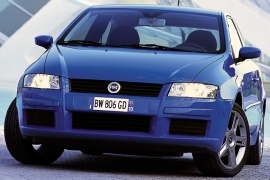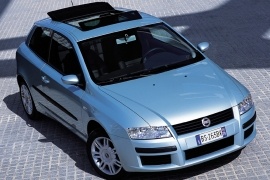FIAT Stilo 3 Doors Models/Series Timeline, Specifications & Photos
First production year: 2001
Engines: Gasoline, Diesel
Body style: Hatchback
In late 2003, Fiat unveiled the facelifted version of its compact-sized Stilo hatchback, which was available in three body shapes: three-doors, five-doors, and station wagon.
The three-door Stilo was unveiled in March 2001, and sales started in the autumn of the same year. While the compact segment was crowded with similar vehicles from all the leading mass-market automakers, Fiat managed to find 350,000 customers (all three bodywork versions combined) until the facelift’s launch, and 125,000 of them were three doors. As a result, the Italian automaker considered it a success and tried to continue its sales streak with an updated and upgraded version of the vehicle. Even though it mainly focused on the drivetrains and interiors, it also performed some aesthetic changes to make the Stilo look fresh again, even though it wasn’t an old car either. Its edge design aged well, and it still looked far ahead of some of its competitors.
At the front, the automaker installed clear headlights that flanked the same rectangular-shaped grille as the one from the 2001 model year. Unlike that, though, the higher grades benefited from a silver slat instead of the all-black design. On the lower side of the bumper, the automaker placed a rectangular air intake flanked by similarly shaped side scoops, as on the non-facelifted version. For the 2004 model year, though, it also featured a lip spoiler underneath the apron.
From its profile, the automaker didn’t focus too much on changing things. It used clear turn signals on the front fenders and body-colored door mirror caps. On the doors and the rear quarter panels, instead, it left the same unpainted, black rubber moldings that protected the bodywork against small bumps in the parking lot or shopping carts for the lower grades, with an option for body-colored ones for the upper ones. Out back, the raked forward tailgate was adorned by a roof spoiler on its upper side. The taillights were slightly redesigned, sporting clear lenses for the turn signal lamps instead of amber-colored ones, as in the 2001 model year.
Inside, the automaker made some changes to make the car look sportier. As a result, it installed white dials with red needles for specific models. The center armrest between the front seats was removed, and customers could have the vehicle fitted with satellite navigation and dual-zone climate control. Furthermore, a boiler-type pre-heater was available for turbodiesel versions. Fiat also included an armrest for the rear bench seat where two adult-sized occupants could sit.
The 2001 Stilo was often criticized for its 1.2-liter gasoline engine, which produced 80 PS (79 hp). Still, its lack of torque made it feel underpowered. As a result, Fiat dropped it in favor of the newly-developed 1.4-liter 16-valve unit, which produced just a mere 8 PS (8hp) more, but since its torque was better, it proved more successful. The automaker also introduced an upgraded version of the 1.9-liter JTD (turbodiesel) unit, which was helped by an intercooler to produce 115 PS (113 hp). This one proved successful in Europe. The 2.4-liter inline-five engine from the Abarth version remained the same, albeit it was paired as standard with a five-speed manual gearbox instead of the sluggish five-speed automated (single-clutch) Selespeed transmission.
Fiat introduced the Stilo at the 2001 Bologna Motor Show as a replacement for the Bravo/Brava lineup, and the hottest version of it was the three-door Abarth.
When the Italian automaker launched the Stilo, it also offered it with an Abarth version. But it wasn’t just a trim level that included some nicer wheels and a set of badges. It was a complete package that included an upgraded suspension, a lower ground clearance, a distinct aerodynamic body kit, and a unique engine. Fiat also pushed hard to enter into the hot hatch segment with this car, trying to challenge vehicles such as the Volkswagen Golf GTI or the Honda Civic Type R. Unfortunately, despite its efforts to promote the Stilo Abarth as a worthy alternative to those vehicles, it couldn’t. However, its customers were spoiled by the features and amenities that were unavailable in most other cars on the market. It featured keyless entry and start, a sat-nav system, and even adaptive cruise control, which in 2001 was a marvel. On top of that, it sported the magic Abarth badge, which was a significant one for Fiat’s fans.
At the front, the Stilo Abarth kept the same angular design shape of the headlights with integrated turn signals as on the rest of the range. They flanked a slatted grille where the carmaker’s badge took center stage. Lower, the bumper featured a rectangular center air intake flanked by a pair of side scoops. Surprisingly, the automaker didn’t consider that the car needed fog lamps, but at least it equipped it with washers for headlights.
From its profile, the 2001 Fiat Stilo Abarth had the same slightly ascending waistline towards the C-pillars. Unlike its other three-door siblings, it rode on unique 17-inch alloy wheels wrapped in 215/45 tires. To make the car look even lower to the ground, Fiat added a set of aerodynamically profiled side sills that visually connected the front and rear wheel arches. Out back, the raked-forward tailgate sported a tiny roof spoiler. As an option, customers could get the Stilo Abarth with a retractable multi-lamellar glass roof, similar to the one offered by the first generation of the Mercedes-Benz A-Class. The rear bumper was adorned on its lower side by a broad and slim horizontal vent, while underneath it, an oval-shaped exhaust expressed the engine’s voice.
Inside, Fiat equipped the Stilo Abarth with many goodies to make its customers happy. As a result, at the front, it placed a set of leather-wrapped bolstered bucket seats separated by a fold-down armrest with an integrated storage compartment. Fronting the driver was a redesigned instrument panel with red needles on white dials, unlike the rest of the Stilo range that sported a white-on-black color scheme. Customers could find a color display for the infotainment system on the center stack that featured a DVD-based navigation system. In the back, the split-folding bench seat was mostly suitable for two occupants, with a fold-down center armrest between them.
Under the hood, Fiat placed a 2.4-liter inline-five gasoline engine rated at 170 PS (168 hp). In the beginning, the car manufacturer provided the Stilo Abarth paired with a five-speed automated (single-clutch) Selespeed gearbox. Later, it replaced that with a standard five-speed manual, while the automated one remained available as an option. The car’s stiffer suspension made it more capable during high-speed cornering.
Fiat replaced the Bravo/Brava lineup after just six years on the market with the Stilo, changing the pace for the Italian automaker in the compact segment, even though the new model wasn’t very successful.
The Italian automaker noticed the change of pace in the design trends and quickly adapted. It ditched the rounded, organic shapes of the biodesign era and went to the straight lines and clear cuts that characterized the Stilo. Unlike the Bravo/Brava, a compact-sized vehicle that used different nameplates for the three- and five-door versions, the Stilo was used for the entire range. That dual-name system didn’t work for Fiat, and it tried to go back to a naming system known by customers. In the three-door version, the Stilo looked more closely to a hot hatch, albeit most of the engines failed to provide the needed punchy feeling. But the car looked good and was available with unique features for those times, including keyless entry and start and standard air conditioning on the entire range. Furthermore, customers could have it with automatic headlights and a panoramic roof with lamellar pieces of glass that could be retracted rearward to create an open-top cabriolet feeling.
At the front, the angular-shaped headlights flanked a black grille that supported the carmaker’s badge. Lower, on the bumper, Fiat installed a broad and rectangular air intake flanked by similarly shaped scoops. Surprisingly, the automaker didn’t offer the Stilo with fog lamps. To protect the bodywork from minor scratches and shopping carts, the automaker added black rubber moldings on the bumper.
With a sporty-looking profile, the Stilo surprised its customers. It looked like a hot hatch, even though, besides the Abarth version, it wasn’t. Its black rubber protections on the doors and rear quarter panels continued to protect the vehicle from side bumps in the parking lot. Fiat also created wider rear fenders, giving the car a muscular look. In addition, it placed body-colored door mirrors and handles, something that even some premium automakers failed to do with their cars. Out back, the raked-forward tailgate was slightly recessed on the lower side compared to the quarter panels and the exposed clear-lenses taillights.
Inside, the three-door Stilo was available in a few trims and provided customers with various features, including a DVD-based navigation system. That was rare in the budget-friendly vehicle segment. But still, Stillo had it. Furthermore, it even provided standard AC with an option for dual-zone climate control and an LCD that showed the airflow and the temperature on the center stack. The instrument cluster was filled with large dials for the tachometer and speedometer, while a monochrome LCD placed on the lower side completed information with data gathered from the onboard computer. Fiat installed comfortable bucket seats at the front, but with little side bolstering. Accessing the rear seats was more challenging due to the car’s low height and the narrow bench seat. On paper, it was a five-seat vehicle, but in real life, it was more of a four-people affair.
Under the hood, sales started with a choice of six engines, four with gasoline and two turbodiesels, ranging between 80 PS (79 hp) and 170 PS (168 hp). Later, the automaker improved the lineup with other powerplants. The entry-level version was a 1.2-liter unit, which was too much underpowered.


